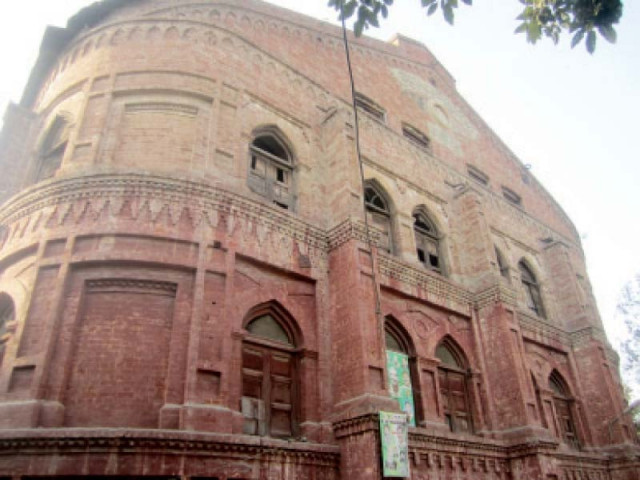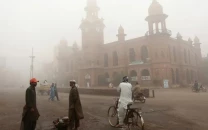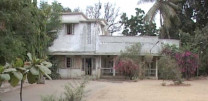Rang De Basanti
Bhagat Singh became a national icon of resistance and bravery and remains so in India

Bhagat Singh became a national icon of resistance and bravery and remains so in India.
On that cold December day, ASP John P Saunders came out of the District Police Lines which were located in the current Zila Kutchery. He was about to start his motor bike, when he was ambushed by two assailants, Rajguru and Bhagat Singh. A pistol load of bullets was pumped into his body. The attackers, ran away. Head Constable Chanan Singh gave chase. They shouted warnings at him to desist. When he did not stop, he was shot and killed. His attackers ran into the DAV College, now Islamia College, Civil Lines, which was opposite the police station.
Faiz Ahmed Faiz, who was living in another building across the road, the New Hostel of the Government College, Lahore, is said to have witnessed the scene. According to one account, Bhagat Singh fired from the first floor of the New Hostel. The assailants scaled the back wall, of the DAV College into the student’s hostel where getaway bicycles were waiting for them. They fled to a safe house on Mozang Road. They were taken in by Durga Devi, the wife of a fellow freedom fighter. (Nicely played by Soha Ali Khan in the blockbuster film, Rang De Basanti).
Alarm was sounded throughout Lahore. The railway station was swarming with the police and the CID. Bhagat Singh, attired in western dress, posing as a government official, strode forward with cool confidence to buy a first class ticket. Durga Bhabi played the role of a subservient eastern wife, with a three year old child and Rajguru, became their servant. They were able to leave without arousing suspicion.
Bhagat Singh was born to Sardar Kishen Singh and Vidyavati in Banga village, Jarawnwala tehsil in 1910. He went to the DAV School (Dyanand Anglo Vedic School), Lahore, now Muslim League High School No: 2. He attended the National College, between 1922-26, which functioned at the Bradlaugh Hall, located at a stone’s throw from the Zila Kutchery. This imposing building was built by Sardar Dyal Singh Majithia from funds generated to pay homage to Charles Bradlaugh, the British MP from Northampton who was a vocal supporter of the Indian Home Rule. Mrs Annie Besant who later became the doyenne of Indian freedom politics, had been his political votary.
Bradlaugh had an eventful time in the House of Commons. He was an avowed atheist and the founder of the National Secular Society. He was the editor of the secularist newspaper, the National Reformer, which was prosecuted by the British government for blasphemy and sedition. When elected to the House of Commons in 1880, he refused to take an oath which required the member to confirm his Christian and monarchist credentials. After a prolonged parliamentary procedure, he was disqualified and briefly imprisoned in the small cell in the House of Commons. The good citizens of Northampton reelected him four times, before the law was changed six years later and he was able to take his oath of membership.
He and Mrs Annie Besant published a pamphlet on birth control in 1877. They were tried on the charge of obscenity and found guilty. They faced a large fine and a jail sentence, although this was overturned by the court of appeal. Bradlaugh spoke in the parliament about the London Match Girls Strike of 1888. They were protesting against their working conditions which led to phosphorus poisoning and manifested itself as the dreadful and fatal condition called the Phossy Jaw. Ultimately, the use of white phosphorus was restricted and then banned.
Bradlaugh addresed the Bombay session of the Indian National Congress in 1889 and spoke in favour of the home rule for India. He was affectionately called the MP for India.
The Bradlaugh Hall was built on the Rattigan Road in 1900. It was inaugurated by the grand old man of Indian politics, Surendra Nath Bannerji.
Lala Lajpat Rai was a respected educationist and a nationalist politician. He was associated with the Hindu revivalist Arya Samaj movement and therefore his outlook differed from that of Bhagat Singh, who was a socialist and an atheist. The DAV School and the National College were founded by the Lala.
During the years of the first world war, he was in North America. He was in touch with the Ghadar Party which was founded by immigrant students in the University of California, Berkley. It aimed to achieve the independence of India through armed struggle. These revolutionaries were planning to take over the Mian Mir Cantonement, (Lahore Cantt.), when they were arrested by the police and eventually tried and executed. They had used the Bradlaugh Hall as their base.
It was at the Bradlaugh Hall that Bhagat Singh founded the Naujawan Bharat Sabha which aimed at using revolutionary and non communal methods to achieve the complete independence of India. This building also housed the Hindustan Socialist Republican Association, HSRA, renamed ‘Socialist’ and led by Bhagat Singh.
In 1928, the British government sent a delegation to India under the leadership of Sir John Simon. It was a ten yearly review of the Indian move towards Self Rule, mandated under the Montague-Chelmsford reform implemented in 1919. The Congress and the Muslim League boycotted the Simon Commission, as it did not have any Indian members. There was a noisy protest and a blockade outside the City railway station when the Commission arrived here. The superintendent of the Police, JA Scott ordered lathi charge and personally beat up Lala Lajpat Rai. He was badly injured and died a few days later. As he lay dying, Bhagat Singh and his friends swore revenge. In the event, the SP did not come to work on the day of the planned assassination and ASP Saunders was misidentified and killed instead.
Bhagat Singh was eventually captured and put on trial for this and other revolutionary activities. He was already a national celebrity along with Rajguru and Sukhdev. They were detained at the Lahore Central Jail, which has been demolished and is now the site of Shadman Colony. They went on hunger strike demanding improvement in the physical conditions of the prison. Jinnah had this to say about the strikers:
“The man who goes on hunger strike has a soul. He is moved by that soul, and he believes in the justice of his cause. However much you deplore them and however much you say they are misguided, it is the system, this damnable system of governance, which is resented by the people”.
The trio were condemned to death and executed on 23rd of March, 1931. Where the phansi ghat once stood, we now have the second Shadman roundabout, with fountains.
The Bradlaugh Hall was once a repository of our national aspirations and saw a ferment of intellectual and political activities. Bhagat Singh became a national icon of resistance and bravery and remains so in India. We have forgotten this part of our history and neglected this beautiful building which has become a derelict site. I went to school in close vicinity but never knew of the Bradlaugh Hall or the story of Bhagat Singh. On the stage where once, people like Nehru, Jinnah and Iqbal addressed the community, there is trash, broken furniture and empty bottles of vodka. In a counterfactual history, we would have the highest grossing Bollywood movie made here, on the original location and visitors coming from all over the world to pay tribute.
Actually, I think that there is still material here for many more poems, books, dramas and films. Maybe we can start with Kartar Singh Sarabha the revolutionary of the Ghadar Party and a student of UC Berkley. He was executed in 1915, aged 19. In his death cell he wrote:
Seva des the jidariae bari aukhi
Gallan karnian dher sukhalian nen
Jinnan des the seva che paer paya
auhnan lakhan musibatan palian nen
Serving the nation is hard
T’is much easier to spin a yarn.
Those who dare to travel this road
Face unending toil and woes
Any takers?
Athar Ahmed Saeed is a physician and lives in Durham, United Kingdom. Follow him on Twitter, HakimHazik@Twitter.com
Published in The Express Tribune, March 20th, 2016.



















COMMENTS
Comments are moderated and generally will be posted if they are on-topic and not abusive.
For more information, please see our Comments FAQ